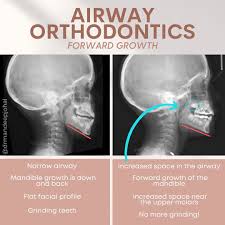Using MARPE + Invisalign on the Upper Jaw and a Homeoblock with Bite Plane on the Lower Jaw
For patients with small upper and lower jaws, the symptoms are often more than just crooked and crowded teeth. They may experience chronic clenching or grinding, TMJ discomfort, neck and trap tension, headaches, and facial asymmetry—along with breathing or sleep-related issues. In these more complex cases multiple airway orthodontic appliances may be necessary. In this article we discuss a protocol involving treatments using MARPE, Invisalign and Homeoblock appliances at the same time.
At our practice, we’ve developed a multi-faceted treatment protocol that targets the root of these problems by addressing skeletal development, neuromuscular function, and airway health all at once. This protocol combines:
- MARPE (Mini-implant Assisted Rapid Palatal Expander)
- Invisalign clear aligners
- The Homeoblock appliance with a bite plane
Here’s how this powerful combination works.
Upper Jaw: MARPE + Invisalign (Simultaneously)
The combination of MARPE and Invisalign clear aligners is very powerful for people who need large amounts of palatal expansion and cranial-facial growth. We use MARPE for controlled skeletal expansion of the upper jaw. Unlike traditional rapid methods, we implement a slow, biologically guided expansion (MASPE), which allows the craniofacial structures to adapt more harmoniously.
At the same time, Invisalign aligners are used to:
Benefits of Clear Aligners with Palatal Expansion
- Begin aligning the teeth during expansion
- Minimize visible gaps like midline diastema
- Help control tooth positioning as the palate grows
- Expands the nasal cavity to improve breathing
- Creates proper space for the tongue
- Begins correcting the bite early in treatment, reducing total time
Lower Jaw: Homeoblock with a Neutral Bite Plane
Patients with clenching, facial asymmetry, or chronic muscle tension benefit tremendously from the Homeoblock appliance, especially when equipped with a customized bite plane. This bite plane is more than just a protective surface, it’s designed to establish a neutral bite position.
What Is a Neutral Bite Position?
A neutral position is a structural alignment where the muscles of the jaw, face, neck, and shoulders come to rest. When the bite plane is properly calibrated, it allows the jaws to close in this neutral position, which:
- Unloads chronically overworked muscles of the jaw, head, neck, and traps
- Reduces muscle tension and postural strain
- Helps alleviate TMJ pain, neck tightness, and clenching-induced headaches
- Provides a stable muscular foundation for functional bone remodeling
How It Guides Bone Growth
Because the neutral bite position stabilizes the jaw, it creates the optimal environment for the Homeoblock’s epigenetic stimulation to work effectively. The appliance gently encourages:
- Lower jaw expansion, particularly beneficial when the lower arch is narrow
- Improved jaw symmetry, as the muscles stop pulling unevenly on bony structures
- Better facial balance, as growth patterns become more physiologically aligned
This makes the Homeoblock with a neutral bite plane critical for patients with facial asymmetries, chronic bruxism, and head/neck tension—not just for protecting the teeth but for driving cranial growth in the right direction.
Who Needs the Neutral Bite Plane?
Not every patient needs this level of intervention. Patients with airway problems, mouth breathing, or sleep-disordered breathing may benefit more from upper expansion and tongue space correction alone.
But for those who also suffer from:
- Chronic clenching or grinding
- Facial or jaw asymmetry
- Neck, jaw, or shoulder tension
- Postural dysfunction
The addition of a lower jaw expander with a neutral bite plane is essential for people who clench their teeth and have jaw and neck tension and headaches.
Why MARPE + Invisalign + Homeoblock Is So Effective
By addressing both skeletal structure and neuromuscular balance, this protocol:
- Accelerates treatment by correcting jaw size and tooth alignment simultaneously
- Relaxes and protects muscles and joints from overload during treatment
- Enhances facial harmony through guided bone remodeling
- Improves sleep and breathing by enlarging tongue space and thereby decreasing airway resistance and airway obstruction
- Reduces the chance of relapse by creating a structurally and functionally stable bite
Summary: Function Meets Form
This combined protocol reflects the philosophy of airway-centered, craniofacial orthopedics: it’s not just about straight teeth, but about restoring harmony to the structure, function, and neurology of the face and jaws.
 703-712-1053
703-712-1053 
